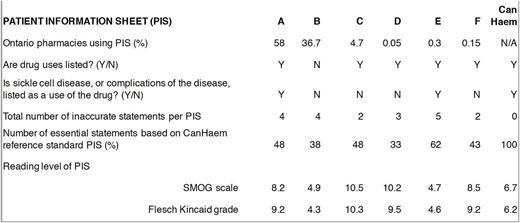Abstract
BACKGROUND: Hydroxyurea (HU) remains a cornerstone of sickle cell disease (SCD) therapy however its clinical efficacy may be limited by poor patient acceptance and adherence. While barriers to HU use are multifold, patients often relay fears relating to potential side effects of HU as a contributor to drug non-adherence. A common source of information on HU side effects is the patient information handouts (PIHs) that are routinely distributed by pharmacies when dispensing a prescription. We sought to formally evaluate the content and accuracy of HU pharmacy PIHs, including comparison of content with a reference standard PIH developed by the Canadian Haemoglobinopathy Association.
METHODS: We obtained a comprehensive list of all accredited pharmacies in Ontario, Canada in 2016 from the Ontario College of Pharmacists (OCP), which totalled 4,150 pharmacies. A representative sample of pharmacies were subsequently contacted by telephone or in-person to obtain pharmacy PIHs on HU. PIHs were assessed according to listed uses of HU, number of inaccurate statements, essential statements based on comparison to the CanHaem reference standard PIH, and reading level (using Flesch-Kincaid and SMOG scales).
RESULTS: Six unique HU PIHs were identified, which represented approximately 95% of Ontario pharmacies; PIH A and B were used by 58% and 36.7% of pharmacies, respectively (Table 1). While most of the PIHs listed uses for HU (60% of Ontario pharmacies in total), only 58.3% identified SCD as an indication for drug use. All PIHs contained statements that could be classified as inaccurate and misleading. The number of inaccurate statements ranged from 2-5 per PIH; 95% of distributed PIHs had an average of 4 inaccurate statements per handout. The most frequently encountered inaccuracy related to development of cancer in patients taking HU, namely acute leukemia. Additional inaccuracies included special handling precautions, vaccine inefficacy and overstating the likelihood of developing rare side effects such as, "deadly bleeding problems and infections," hepatic insufficiency and infertility.
On average, pharmacy PIHs included 45% of essential statements present within the reference standard HU patient handout. Missing information themes involved use of HU for management of SCD and specifically, benefits of HU in preventing SCD complications, long term safety data on HU and differentiation between common and uncommon side effects of HU use.
The reading level of each pharmacy PIH was also assessed and compared to the grade 6 reading level formally advised for written patient information materials by the National Work Group on Literacy and Health. The average reading level across pharmacy PIHs was 7.85 and 7.83 according to the Flesch Kincaid and SMOG scales, respectively. However, 58% of Ontario pharmacies distributed PIHs with a reading level of 9.2 and 8.2 (Flesch Kincaid and SMOG, respectively) in comparison to the grade 6.2 and 6.7 (Flesch Kincaid and SMOG, respectively) reading level of the CanHaem PIH.
CONCLUSION: SCD patients in Ontario who are prescribed HU are likely to receive written information materials from pharmacies that contain inaccurate and misleading statements weighted heavily toward risks of HU therapy and run contrary to published literature. Moreover, the PIHs reviewed in this study contained only 45% of the content deemed necessary for patient education on HU by a panel of experts in SCD. Oftentimes, this information requires a comprehension level beyond that recommended for patients. Through the itemization of written information provided to patients when obtaining their HU prescription, this study identifies a potential gap in the care of SCD patients and an opportunity to improve on the quality of HU PIHs to help patients make well-informed decisions about their health.
No relevant conflicts of interest to declare.
Author notes
Asterisk with author names denotes non-ASH members.


